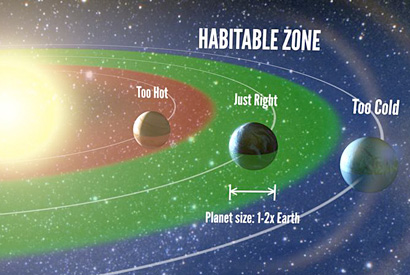All information on this page
is embargoed until 3 p.m. EST (12 noon PST)
on Monday, Nov. 4,
in accordance with the embargo by the journal
Proceedings of the National Academy of Sciences
Links to low and high resolution video for use after the embargo:
astro.berkeley.edu/~gmarcy/EtaEarth_lowres_EMBARGOED.mov
astro.berkeley.edu/~gmarcy/EtaEarth_hi_res_EMBARGOED.mov
Please credit video to Petigura/UC Berkeley, Howard/UH-Manoa, Marcy/UC Berkeley, Illumina Studies, Emeryville, Calif.
Please credit images to Petigura/UC Berkeley, Howard/UH-Manoa, Marcy/UC Berkeley.
 SLIDE 1: The field of view of the Kepler space telescope, located in the constellation Cygnus, just above the plane of the Milky Way Galaxy. Kepler made precise measurements of the brightnesses of 156,000 stars for four years. Kepler was launched in March, 2009 and completed its nominal mission in November, 2012. Kepler ceased normal operations in May, 2013. (Click image for higher resolution)
SLIDE 1: The field of view of the Kepler space telescope, located in the constellation Cygnus, just above the plane of the Milky Way Galaxy. Kepler made precise measurements of the brightnesses of 156,000 stars for four years. Kepler was launched in March, 2009 and completed its nominal mission in November, 2012. Kepler ceased normal operations in May, 2013. (Click image for higher resolution)
 SLIDE 2: Artist’s representation of the “habitable zone,” the range of orbits where liquid water is permitted on the surface of a planet. The authors find that 22±8% of Sun-like stars harbor a planet between one and two times the size of Earth in the habitable zone.(Click image for higher resolution)
SLIDE 2: Artist’s representation of the “habitable zone,” the range of orbits where liquid water is permitted on the surface of a planet. The authors find that 22±8% of Sun-like stars harbor a planet between one and two times the size of Earth in the habitable zone.(Click image for higher resolution)
 SLIDE 3: Analysis of four years of precision measurements from Kepler shows that 22±8% of Sun-like stars have Earth-sized planets in the habitable zone. If these planets are as prevalent locally as they are in Kepler field, then the distance to the nearest one is around 12 light-years.(Click image for higher resolution)
SLIDE 3: Analysis of four years of precision measurements from Kepler shows that 22±8% of Sun-like stars have Earth-sized planets in the habitable zone. If these planets are as prevalent locally as they are in Kepler field, then the distance to the nearest one is around 12 light-years.(Click image for higher resolution)
